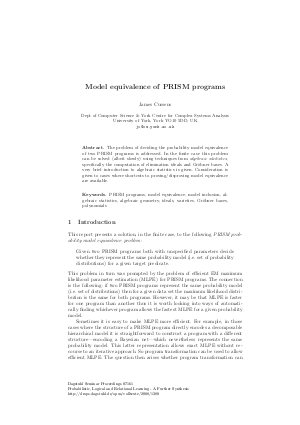Model equivalence of PRISM programs
Author James Cussens
-
Part of:
Volume:
Dagstuhl Seminar Proceedings, Volume 7161
Part of: Series: Dagstuhl Seminar Proceedings (DagSemProc) - License:
 Creative Commons Attribution 4.0 International license
Creative Commons Attribution 4.0 International license
- Publication Date: 2008-03-06
File

PDF
DagSemProc.07161.7.pdf
- Filesize: 192 kB
- 21 pages
Document Identifiers
Subject Classification
Keywords
- PRISM programs
- model equivalence
- model inclusion
- algebraic statistics
- algebraic geometry
- ideals
- varieties
- Gr"{o}bner bases
- polynomials
Metrics
- Access Statistics
-
Total Accesses (updated on a weekly basis)
0PDF Downloads0Metadata Views
Abstract
The problem of deciding the probability model equivalence of two
PRISM programs is addressed. In the finite case this problem can be
solved (albeit slowly) using techniques from emph{algebraic
statistics}, specifically the computation of elimination ideals
and Gr"{o}bner bases. A very brief introduction to algebraic
statistics is given. Consideration is given to cases where shortcuts
to proving/disproving model equivalence are available.
Cite As Get BibTex
James Cussens. Model equivalence of PRISM programs. In Probabilistic, Logical and Relational Learning - A Further Synthesis. Dagstuhl Seminar Proceedings, Volume 7161, pp. 1-21, Schloss Dagstuhl – Leibniz-Zentrum für Informatik (2008)
https://doi.org/10.4230/DagSemProc.07161.7
BibTex
@InProceedings{cussens:DagSemProc.07161.7,
author = {Cussens, James},
title = {{Model equivalence of PRISM programs}},
booktitle = {Probabilistic, Logical and Relational Learning - A Further Synthesis},
pages = {1--21},
series = {Dagstuhl Seminar Proceedings (DagSemProc)},
ISSN = {1862-4405},
year = {2008},
volume = {7161},
editor = {Luc de Raedt and Thomas Dietterich and Lise Getoor and Kristian Kersting and Stephen H. Muggleton},
publisher = {Schloss Dagstuhl -- Leibniz-Zentrum f{\"u}r Informatik},
address = {Dagstuhl, Germany},
URL = {https://drops.dagstuhl.de/entities/document/10.4230/DagSemProc.07161.7},
URN = {urn:nbn:de:0030-drops-13808},
doi = {10.4230/DagSemProc.07161.7},
annote = {Keywords: PRISM programs, model equivalence, model inclusion, algebraic statistics, algebraic geometry, ideals, varieties, Gr"\{o\}bner bases, polynomials}
}
